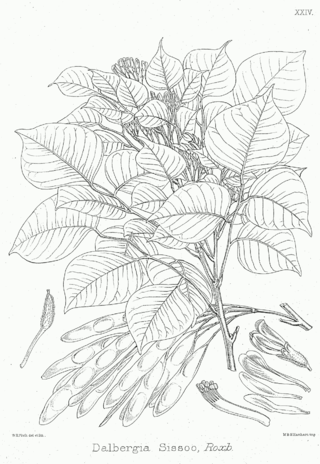
Dalbergia is a large genus of small to medium-size trees, shrubs and lianas in the pea family, Fabaceae, subfamily Faboideae. It was recently assigned to the informal monophyletic Dalbergia clade : the Dalbergieae. The genus has a wide distribution, native to the tropical regions of Central and South America, Africa, Madagascar and southern Asia.

Argyreia is a genus of plants in the family Convolvulaceae.

Cissus is a genus of approximately 350 species of lianas in the grape family (Vitaceae). They have a cosmopolitan distribution, though the majority are to be found in the tropics.

Indigofera is a large genus of over 750 species of flowering plants belonging to the pea family Fabaceae. They are widely distributed throughout the tropical and subtropical regions of the world.

Gynura is a genus of flowering plants in the daisy family Asteraceae native to Asia. The best known species is Gynura aurantiaca, often grown as a house plant. This plant is commonly known as purple passion because of the velvety purple leaves.

Archidendron is a genus of flowering plants in the pea family, Fabaceae. It includes 98 species which range from India through Indochina, southern China, Taiwan, Malesia, and Papuasia to Queensland and New South Wales.

Ormosia is a genus of legumes. 131 living species, mostly trees or large shrubs, are native to the tropical Americas, from southwestern Mexico to Bolivia and southern Brazil, to southern, southeastern, and eastern Asia, and to New Guinea and Queensland. Most are tropical, while some extend into temperate temperate regions of China. A few species are threatened by habitat destruction, while the Hainan ormosia is probably extinct already.

Adinandra is a genus of plant in the family Pentaphylacaceae. It contains the following species:

Gymnosporia is an Old World genus of plants, that comprise suffrutices, shrubs and trees. It was formerly considered congeneric with Maytenus, but more recent investigations separated it based on the presence of achyblasts and spines, alternate leaves or fascicles of leaves, an inflorescence that forms a dichasium, mostly unisexual flowers, and fruit forming a dehiscent capsule, with an aril on the seed. It is dioecious, with male and female flowers on separate plants.

Dunbaria is a genus of flowering plants in the legume family, Fabaceae. It belongs to the subfamily Faboideae. It includes 19 species which range from India to Indochina, China, Korea, Japan, Malesia, New Guinea, and northern Australia.

Flemingia is a genus of plants in the legume family Fabaceae. It is native sub-Saharan Africa, Yemen, tropical Asia, and Australasia. In Asia the species are distributed in Bhutan, Burma, China, India; Indonesia, Laos, Malaysia, Nepal, Pakistan, Papua New Guinea, Philippines, Sri Lanka, Taiwan, Thailand and Vietnam. The genus was erected in 1812.

Spatholobus is a genus of flowering plants in the legume family Fabaceae. It includes 35 species of lianas which range from the Indian subcontinent to Indochina, southern China, and western Malesia. It grows in seasonally-dry to evergreen tropical forest and thicket, often on rocky slopes and in disturbed areas. It belongs to subfamily Faboideae.

The tribe Millettieae is one of the subdivisions of the plant family Fabaceae.
Hedyotis (starviolet) is a genus of flowering plants in the family Rubiaceae. Many species of this genus such as Hedyotis biflora, H. corymbosa and H. diffusa are well known medicinal plants. Hedyotis is native to tropical and subtropical Asia and to islands of the northwest Pacific. It comprises about 115 species. The type species for the genus is Hedyotis fruticosa.

Dendrophthoe is a genus of hemiparasitic shrubs found in Asia and Australia known as mistletoes. The genus was described by German naturalist Carl Friedrich Philipp von Martius in 1830. Species in this genus have a variety of reported uses in the medical traditions of the region, most notably in Nepal.

Phanera is a genus of flowering plants in the legume subfamily Cercidoideae and the tribe Bauhinieae. This genus differs from Bauhinia in being vines or lianas, generally with tendrils and a lobed rather than spathaceous calyx, and from Schnella in having only three fertile stamens rather than ten, and being native to the Indomalayan realm and the Australasian realm rather than the Americas. The subsection Corymbosae was recently segregated into a new genus, Cheniella. It has been suggested that the genus Lasiobema should be reduced to a section within Phanera.
Brachypterum is a genus of flowering plants in the pea family (Fabaceae). It includes eleven species, which range from the Indian Subcontinent through Indochina, southern China, Malesia, New Guinea, and eastern Australia.















